This article was published in Scientific American’s former blog network and reflects the views of the author, not necessarily those of Scientific American
As you’ll know if you’ve read those previous articles (part 1 here, part 2 here, part 3 here), 2015 was another horribly biased year for Tet Zoo. Charismatic megafauna – mammals and dinosaurs in particular – won out over smaller, more obscure beasts.
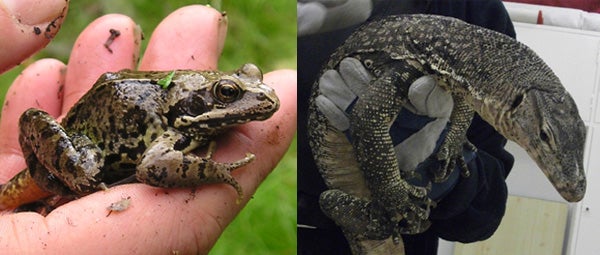
Stuff that Tet Zoo needs more of: frogs and lizards. At left, Rana temporaria. At right: Varanus salvator. Photos by Darren Naish.
And if we look at analyses of Tet Zoo coverage presented here in years past, we see that nothing much has changed. Those big, sexy animals win coverage every time, despite my efforts. This is mostly, I think, because it’s easier for me to write about them than it is those animals that actually need more coverage. What the hell, you’ve heard me say all of this before, and I’ll continue to strive for something approaching taxonomic balance. I should say that it isn’t just taxonomic balance I have in mind. I also consider it my moral duty here to (1) disseminate information on obscure animals, this information typically being locked away in the technical literature and often having little or no internet presence; and (2) raise and/or discuss awareness of issues regarding the conservation of little-known animals. To that end, expect another year where I promise to write more about frogs, lizards, obscure rodents and fossil groups that otherwise win little online coverage.
On supporting science journalism
If you're enjoying this article, consider supporting our award-winning journalism by subscribing. By purchasing a subscription you are helping to ensure the future of impactful stories about the discoveries and ideas shaping our world today.
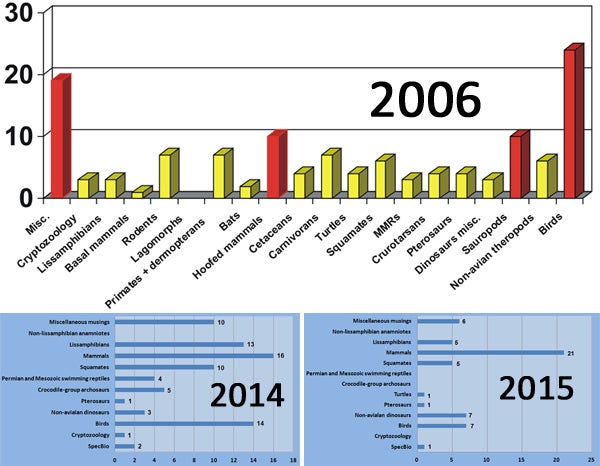
The (seemingly) unavoidable pull of charismatic megafauna - nothing ever changes, as is obvious from these graphs spanning ten years of coverage...
Enough of that. Regular readers will also know that the last couple of years were critical here in that they saw the establishment of what we now call the TetZooniverse – an established brand or empire that incorporateswebcomics, a podcast, an annual convention, merchandise and a dedicated wiki.

A special short edition of the Tet Zoo webcomic, by Gareth Monger.
The Tet Zoo wiki – thanks to Cameron for getting the ball rolling and to everyone else who has assisted with its maintenance and construction (it does have a bit of a spam problem) – is a brilliantly useful guide to Tet Zoo content and I’ve consulted it many times while preparing these 10th birthday articles. Indeed, the chronologically arranged lists of articles have been invaluable. Looking at those lists, perhaps the most curious thing – besides the sheer volume of Tet Zoo content – is how things have changed as goes monthly output. I am staggered when I see that I managed to push out as many as 15 articles a month or more during 2006 and 2007. These days I sometimes struggle to keep to my contracted four articles a month. Then again, things were very different back then and I look at that period as a critical time of brand establishment.
Transferring Content to Print
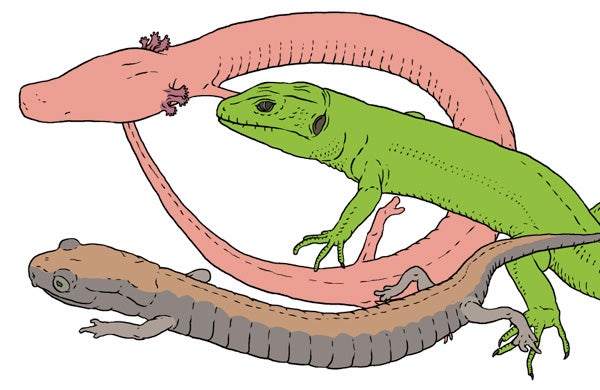
Detail of a scene you might recognise from a book cover. Olm, hynobiid salamander, green lizard. Image by Memo Kosemen.
Having all that content online is handy (more on that content below), but the ephemeral nature of blogging – the fact that a blog host can die, or accidentally or deliberately delete part of its hosted content – means that there’s that constant risk that some or even much of Tet Zoo’s content (I’m thinking of Tet Zoo ver 2, the ScienceBlogs years) might disappear. Yes yes, I know that – so my techy allies tell me – ‘nothing’ is ever really ‘lost’ online, but the fact remains that content can be made essentially impossible to find unless you go to special effort, and this is hardly conducive to the concept that blog content should be easily findable and a force for good when it comes to the dissemination of obscure information.
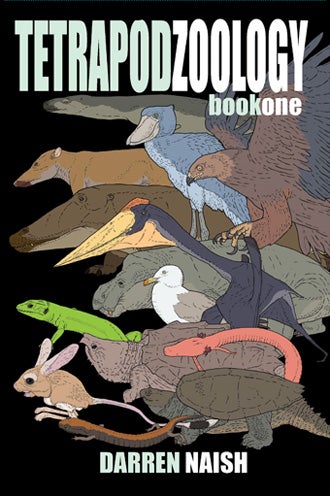
It’s partly for this reason that the idea of transferring Tet Zoo content to book form was devised (and I owe thanks to Karl Shuker and Jon Downes for pushing me in that direction too). Tetrapod Zoology Book One, published in 2010, represents the first step in that process. The plan is to get the rest of Tet Zoo’s content into book form, but it’s slow going since other work and commitments have prevented this so far, as they have so many things.
The Tet Zoo Technical Papers
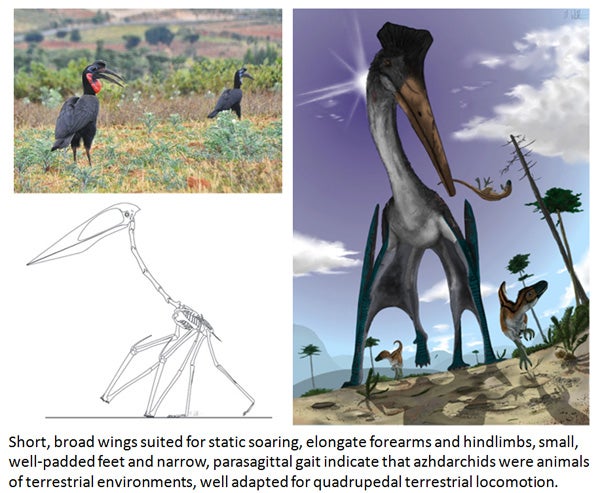
A terrestrial stalking azhdarchid montage, with ground hornbills at upper left (photo by Rod Waddington, CC BY-SA 2.0). The skeleton and reconstruction are by Mark Witton.
Adapting Tet Zoo content to book form is easy enough. But what about turning various of the observations, ideas and hypotheses discussed here over the years into technical papers? Several pieces initially released here as blog articles were revamped and transformed into submitted papers, though not as many as I might like. The terrestrial stalking angle for azhdarchid pterosaurs, published by Mark Witton and myself in a fairly well known open access paper (Witton & Naish 2008), evolved in part from a Tet Zoo article published in 2006, and Mark and I (and others) have since covered azhdarchid palaeobiology in several other articles (Vremir et al. 2014, Witton & Naish 2015).
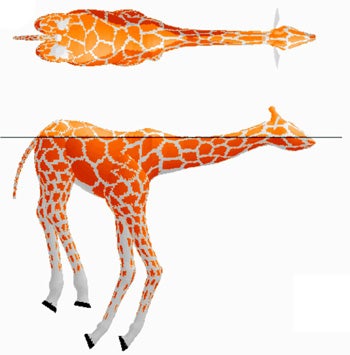
Digital swimming giraffe from Henderson & Naish (2010).
Blog-relevant thoughts on the floating and swimming abilities of giraffes resulted in the technical paper published by Don Henderson and myself in 2010 (Henderson & Naish 2010) and an attempt to identify a ‘mystery’ mammal carcass found on a beach in Australia led to Naish (2012). A 2007 article on alleged mystery big cats from the Peruvian Amazon led to a collaboration in which myself and colleagues analysed the skulls themselves (Naish et al. 2014): they seemed not to be from ‘mystery’ big cats at all.

Publishing scientists pay some attention to citation indices, downloads and such. Here's a graph.
Hey, wow, four papers evolving out of blog articles… that’s not bad at all (there are book reviews too, but I can’t be bothered to count them). There’s also my paper on early ideas about skeletal pneumaticity in dinosaurs (Naish 2010), but that evolved from an SV-POW! article, not a Tet Zoo one. Anyway, there are plenty of other Tet Zoo articles that I really should have turned into technical articles: the proposal that Concavenator’s alleged quill nodes might be something other than quill nodes comes to mind…
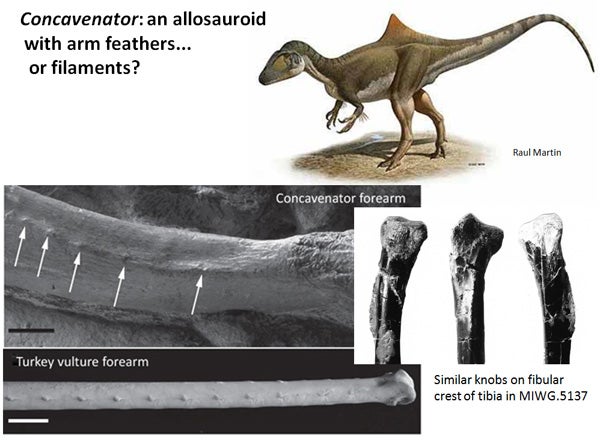
The argument has been made that the row of knobs on the Concavenator ulna might not be quill knobs, but features of an intermuscular ridge. Here's a slide I use in talks (the Concavenator and turkey vulture images are from Ortega et al. (2010)). A counter-argument to this argument has since appeared.
Of course, the nature of scientific blogging is that I have, of course, often written blog articles that discuss my own published papers – I think that all working scientists who blog do this – and hence a substantial component of Tet Zoo’s coverage over the previous ten years relates to my own research interests and experiences. The hypothesis that sexual selection might have driven the evolution of elaborate structures in fossil archosaurs, the Cretaceous ichthyosaur revolution, dinosaur palaeobiology and life appearance, azhdarchoid pterosaurs, and the diversity, anatomy, taxonomy and phylogeny of dinosaurs from the English Wealden Supergroup have all been covered here a disproportionate amount. Hm, this all helps accounts for that massive skew toward charismatic megafauna, how annoying.
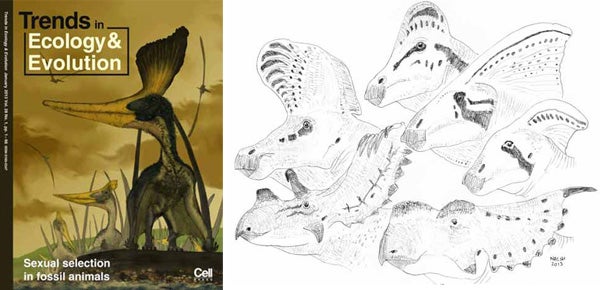
Sexual selection and Mesozoic dinosaurs... familiar topics to Tet Zoo readers. Journal cover (art by Mark Witton) relevant to Knell et al. (2012).
Tet Zoo’s Greatest Hits
I think it’s fair to say that all or nearly all of those subjects just mentioned are popular among readers, and some have been the subject of a fair amount of discussion and debate, both within and outside of the blogosphere. On that note, it’s been interesting seeing which of the various subjects I’ve written about have proved most popular and most inspirational.
So, what I’ve done is trawl through the entire 10-year back catalogue of Tet Zoo content and picked out those things that, I think, have been the focus of the most substantial interest (as goes numbers of visits), or have been especially significant as goes the generating of follow-up discussion, debate or content (as in: art, memes, inspired articles). For a different spin on the same sort of thing, see this 2011 article of personally selected Tet Zoo highlights by superfan Alberta Claw. Anyway, among Tet Zoo’s ‘greatest hits’ are…
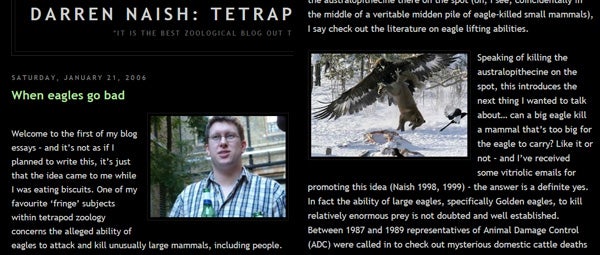
Where it all started...
January 2006: eagles can be macropredators
April 2006: azhdarchids are mooted as stork analogues (the ancestor of Witton & Naish 2008, and with the most recent update being that of December 2013)
May 2006: why rabbits are the freakiest mammals (desperately needs an updated version!)
August 2006: bucorvid hornbills mooted as pseudo-hominid analogues
October 2006: are domestic dogs really wolves? (I no longer stand by the hypothesis promoted in this article, as explained in this piece from 2015)
October and November 2006: phorusrhacids!
February 2007: the science of Godzilla (revisited in November 2010)
March 2007: Australian feral mega-cats
April 2007: rhinogradentians
April 2007: Aetogate (revisited in June 2008)
December 2007: Loch Ness monster photos are evaluated (revisited in July 2013)
March 2008: the hypothesis of initial bipedalism
April 2008: mammals are actually amphisbaenians (revisited in April 2012)
July 2008: a week of sea monsters
August 2008: the ‘Montauk monster’ is a dead raccoon
April 2010: toilet sloths
February and March 2010: a whole bunch of articles on babirusas
June 2012: terrifying penises of turtles
July 2012: why you have to ignore ReptileEvolution.com
October 2012: the ‘intelligent dinosaurs’ meme is revisited, again
February 2013: Great tits as rapacious, flesh-rending predators
April 2013: the Squamozoic is launched
June 2013: the Hoser problem
August 2013: tapir attacks (includes incredible firsthand stuff in the comments)
November 2013: tool use is proposed for crocodylians
December 2013: there’s a new tapir
April 2014: Maximum cassowary
April 2014: the Dougal Dixon interview
May 2014: ratite biogeography… with a string of over 600 panbiogeography-themed comments
July 2014: the first ever TetZooCon
July 2014: humans among the primates (cough original title cough)
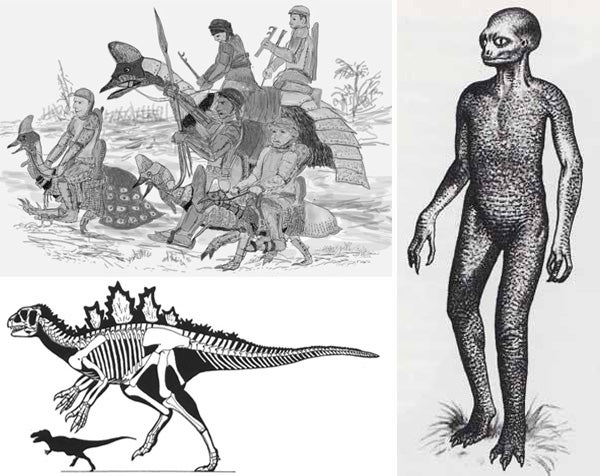
Mainstay highlight posterchildren of Tet Zoo... battle cassowaries (by Darren Naish), Godzilla (diagram by Ken Carpenter), dinosauroid (by John Sibbick).
It will be interesting, in another ten year’s time, to look back again and see which of the post-2015 articles can be deemed significant in the same way. Or is it that this won’t happen again? Is it that we’ve passed a Golden Age of Tet Zoo revelations, and that there are no awesome and amazing things yet to cover? I doubt that, personally, but let’s see.
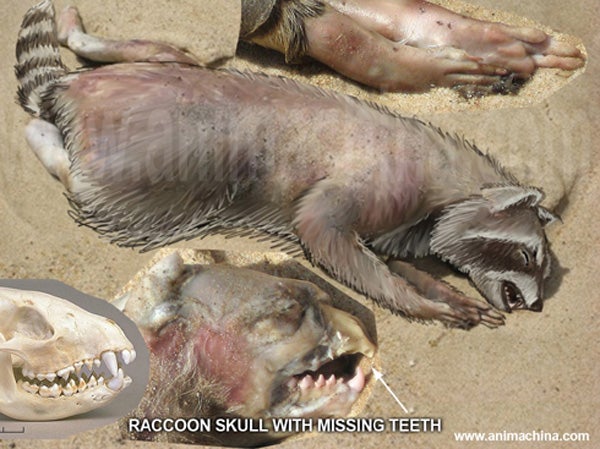
An important role that bloggers play is that they counteract, sometimes powerfully, nonsense put out online - a thing that generally wouldn't, and doesn't, happen elsewhere. Exhibit A: the Montauk Monster is not an enigma or a new kind of animal, but a dead raccoon.
My choice of ‘greatest hits’ given above is somewhat subjective. But on the subject of impact and influence, is there any way of evaluating Tet Zoo’s footprint or impact – on the blogosphere, on the shape of the internet, on our perception of how and where zoological discussion is shared and distributed online? Of course, any serious or in-depth discussion of this issue would involve an analysis of networkedness, linkworthiness across blogs and other sites, and maybe a whole load of interviewing.
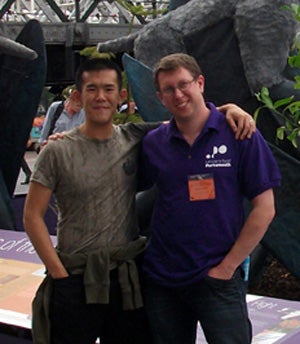
I may not be Ed Yong, but at least I've stood next to him. I'm the one on the right.
There are studies of this sort out there – the best known are probably Fahy & Nisbet (2011) and Shema et al. (2012), others I’ve read include Mahrt & Puschmann (2014) and Jarreau (2015) – but they often don’t provide (or in cases include) data from Tet Zoo so far as I can tell. Hopefully I’m not seeming arrogant in expecting Tet Zoo to warrant analysis or discussion, and maybe it shouldn’t. I’m no Ed Yong or Carl Zimmer.
Nevertheless, I must have said before that Tet Zoo has, in some way, contributed to the ‘scientific blogging movement’, at least with respect to palaeontological and zoological subjects. I mean, people were doing ‘scientific blogging’ long before I started doing stuff in 2006; nevertheless, the success of Tet Zoo has helped further the movement.
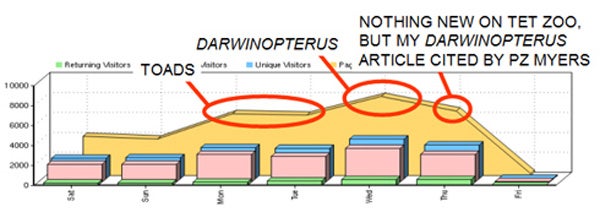
Blog readers are fickle creatures. This graph is from October 2009, the ver 2 years.
With this is mind, I asked fellow bloggers if Tet Zoo was in any way inspirational to their own efforts. I’m pleased to say that I can list at least 18 bloggers who’ve been prepared to admit that Tet Zoo was indeed inspirational, though the caveats are that Tet Zoo was certainly not the sole inspiration to the bloggers concerned, nor necessarily the one that got them blogging in the first place…
Blogs that can be considered ‘related’ to Tet Zoo include those written by Paul Barrett (New Views on Old Bones), Ross Barnett (Twilight Beasts), Andrea Cau (Theropoda), John Hutchinson (What’s In John’s Freezer?), Heinrich Mallison (Dinosaurpalaeo), Matt Martyniuk (DinoGoss), Ben Miller (Extinct Monsters), Zachary Miller (Waxing Paleontological), Mickey Mortimer (Theropod Database Blog), Duane Nash (Antediluvian Salad), William Parker (Chinleana), Brian Spears and Ethan Kocak (Parlour Oceans), Christopher Taylor (Catalogue of Organisms), Jon Tennant (Green Tea and Velociraptors), Scottie Westfall (Natural History), Mark Witton (markwitton.com blog) and Adam Yates (Dracovenator and A Fragment of Gondwana). Note the overwhelming male dominance in that list: it’s no secret that scientific blogging is heavily skewed by gender bias, though things are slowly changing.
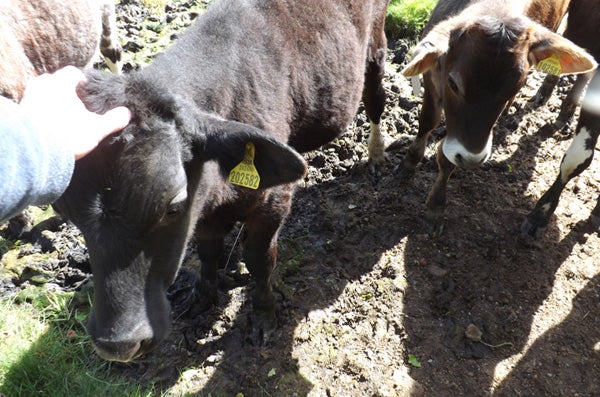
Cows. Not trying to make a point here. I just like cows. We should stop eating them.
So there we have it – this seems like a good place to stop. I apologise for stringing out my birthday-themed thoughts over a whole four articles but there was quite a lot to do and say and not enough time to get it all done at once. Pending unpredictable emergences or calamities, I have no intention to stop blogging, and there are a vast number of things I really want to write about. With these celebrations out of the way, I’ll get back to it. Expect lots of frogs and lizards and obscure extinct things.
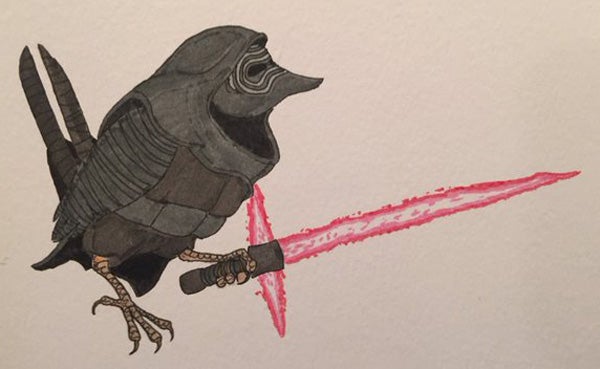
An image that's fairly topical right now, but might seem odd in a few weeks... Nathan Redland's Kylo Wren. Used with permission.
For the previous Tet Zoo birthday articles, see...
It is with some dismay that I announce Tet Zoo's first hemi-decade
Tetrapod Zoology 10th-Birthday Extravaganza, Part 1: 2015 in Review
Tetrapod Zoology 10th Birthday Extravaganza, Part II: the Rest of 2015 Reviewed
Tetrapod Zoology 10th-Birthday Extravaganza, Part 3: Tet Zoo's Tetrapod Treatment in 2015
Refs - -
Fahy, D. & Nisbet, M. C. 2011. The science journalist online: shifting roles and emerging practices. Journalism 12, 778-793.
Henderson, D. M. & Naish, D. 2010. Predicting the buoyancy, equilibrium and potential swimming ability of giraffes by computational analysis. Journal of Theoretical Biology 265, 151-159.
Naish, D. 2010. Pneumaticity, the early years: Wealden Supergroup dinosaurs and the hypothesis of saurischian pneumaticity. In Moody, R. T. J., Buffetaut, E., Naish, D. & Martill, D. M. (eds) Dinosaurs and Other Extinct Saurians: A Historical Perspective. Geological Society, London, Special Publications 343, pp. 229-236.
Naish, D. 2012. Identifying ‘Jaws’, the Margaret River mammal carcase. The Journal of Cryptozoology 1, 45-55.
Ortega, F., Escaso, F. & Sanz, J. L. 2010. A bizarre, humped Carcharodontosauria (Theropoda) from the Lower Cretaceous of Spain. Nature 467, 203-206.